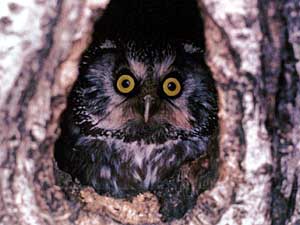|
Audio
Photos
Resources
Your Voice
|
Owlman watches over Minnesota's boreal owls
May 5, 2003
 |
| To the Owlman, Bill Lane, the boreal owl is emblematic of the northwoods. This is a female boreal owl, snug inside the cavity of an old tree. (Photo courtesy of Bill Lane) |
Tofte, Minn. — Every year during the owls' breeding season in late winter and spring, biologist Bill Lane comes to the north shore of Lake Superior near Tofte, Minnesota, to patrol some 850 square miles of boreal forest.
He's looking for owls in general, and one owl in particular -- the boreal owl.
"It's a Jack London species. It's the northern latitudes. It's mush dogs and Canadians and Yukon Jack whiskey," Lane says with a laugh.
 | |||
For 17 years, he's been driving old gravel logging roads through stands of spruce and birch and aspen. Every half mile he gets out and listens in the dark. He writes down the number of owl calls, and the species of each bird -- boreal owl, saw-whet owl, great gray owl, long-eared owl. By visiting the same spots year after year, Lane hopes to get a picture of the owls' abundance, and how that is changing over time.
But boreal owls have a problem. They nest in cavities in old trees. They can't nest in the stands of young trees that grow up after clearcutting.
So the Owlman hates clearcuts. He pulls over by a newly-cut heap of logs piled by the road.
"The reason I wanted to stop here is because this was the one area in my 850-square mile study area that I have always had boreals. And now with this cut, I don't know what the impact is, but I don't have boreals here," Lane says.
The Owlman's unhappiness with the timber industry extends to the U.S. Forest Service and the Minnesota Department of Natural Resources. He sees them as the industry's allies in producing timber at the expense of owls.
 | |||
"Maybe I'm just a hopeless romantic, but you see stuff like this and go, 'Who's making these decisions, for four-inch diameter pulpwood?'" Lane says.
But if you look through the Owlman's data, there's no simple, straight-line equation showing that more logging equals fewer owls.
Owls are much more complicated than that. They have population booms and busts that follow the rodents they prey on. They come and go across the Canadian border, depending on the year, the weather, and other more mysterious factors. But year after year, the Owlman keeps collecting his data.
"A couple nights ago I was driving down this road, and a great gray flew right out in front of me. Perched in a tree. I stopped, and I did a couple of hoots, and he came back out and just sat there and looked at me. It was a standoff," Lane says. "I hate when the sun comes up sometimes -- it's the truth."
This particular spring night, we go to spot after spot. The Northern Lights shimmer in the sky, but we're not having much luck hearing owls -- even the saw-whet owls who were calling madly just a few nights ago.
 | |||
The Owlman whistles like a saw-whet, trying to get one in the distance to come closer and call back.
We stand for a long time, but all we hear is the far-off cries of wolves.
By this time, the Owlman's feeling sorry for the reporter. He gets out a contraption he uses only in desperate situations. It's a megaphone with a digital keypad attached. You punch in a code, and the machine plays a recorded call, to attract the species you want.
After a few false starts, a recorded boreal owl call echoes through the woods, but none calls back.
Owls, it seems, are unpredictable. They're also stubborn. They hang on year after year, despite adversity. You get the feeling that's part of why the Owlman likes them.
|
News Headlines
|
Related Subjects
|
